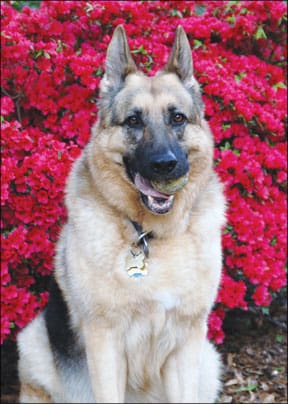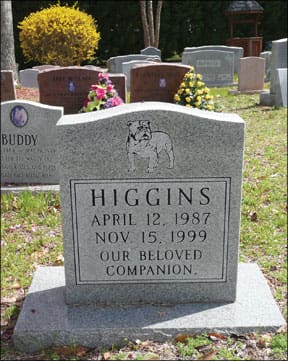[Updated March 26, 2018]
PREPARING FOR A DOG’S PASSING: OVERVIEW
1. Meet with your veterinarian in advance to explore, discuss, and understand all of your options regarding end-of-life decisions for your dog.
2. Take time to say goodbye to your beloved companion, thank him for all the time you’ve spent together, and give him permission to go.
3. Know that you are not in it alone; you should neither mitigate nor apologize for your feelings.
4. Reach out to get the help you need to begin processing your loss.
For many of us, the death of our dog will be the first time that we’ve experienced the loss of a loved one, human or otherwise. And even for those who have lost a relative, spouse, or close friend, dealing with the death of a beloved dog can be a whole new experience, unleashing a wave of emotions that just might sweep us off our feet. Although no amount of preparation can make the pain disappear, planning ahead for the loss of a pet can allow us to make better decisions and be ready with the right resources should we find ourselves on an emotional roller coaster.

Joan MacDonald
Plan Ahead to Give Your Dog the Best Death Possible
If you have a senior or terminally ill dog, it’s a good idea to plan ahead for his passing to ensure a quality death for him, as free from pain and suffering as possible. Advance planning, no matter how difficult, lets us make better decisions and ensures a “good” death for our dog. Many guardians find they have regrets if they wait and try to make decisions in the throes of emotion.
Consider the following well in advance of saying goodbye to your beloved companion:
Do you wish for your dog to die an unassisted death at home?
Can you provide the 24/7 support and care he needs to be sure that he does not suffer? If the process is relatively controlled – that is, you have received professional veterinary guidance to keep your pet pain-free until his last breath – dying an unassisted death at home involves setting up a quiet and comfortable environment for your pet and removing collars, slings, and braces from his body in advance.
Respect your pet’s need to die in peace; stories abound of pets who wait to die until their caregivers leave them alone, preferring a quiet departure to one filled with histrionics.
If striving for an unassisted death at home, what is your backup plan if your dog’s condition rapidly deteriorates or she is in distress?
Know to which veterinary clinic you can take your dog on a moment’s notice, any time of day – for euthanasia should it be necessary. Or, find a veterinarian who offers emergency house call service. Alice Villalobos, DVM, and proponent of “pawspice,” reminds us that breathing is the most important criterion. If your pet can’t breathe comfortably enough to sleep, then there is no quality of life.
If you anticipate that euthanasia will be necessary, where do you wish for your pet to be euthanized?
At home? In another special place? Explore your options in advance, including interviewing house call veterinarians. For some people, choosing in-home euthanasia allows them to more easily express their emotions, pay tribute to the animal, and feel relaxed about spending as much time as they wish, prior to and after their pet passes.
Joan Macdonald, of Atlanta, Georgia, knew in her heart that her 10-year-old, beautiful, black-and-tan German Shepherd, Buck, who was suffering from protein losing enteropathy, would require euthanasia. She says, “I had spoken with a couple of different veterinarians who performed in-home euthanasia about six to eight weeks before Buck’s death and selected the person with whom I felt most comfortable. I understood the process well before the day arrived. I had spoken with the vet two days before to assure myself that I knew she would be available.”
Macdonald’s previous three pets had all died at home; she felt that in-home euthanasia was the most loving option for Buck. “We could be there with him while he was outside in our backyard, a place he loved, surrounded by people and animals who loved him. I had dragged him to enough places while battling his illness; the least I could do was to give him a peaceful death surrounded by blue skies and chirping birds.”
Do you prefer the option of euthanasia at your dog’s veterinary clinic?
Are you comfortable with your veterinarian and her staff, and do you understand the procedure? How does your dog feel about the clinic? If it is a place of stress for her, or if she is very old and relatively immobile, you might wish to consider at-home euthanasia. Or, ask your veterinarian in advance if she would be willing to come out to your car to euthanize the dog, rather than requiring you to bring the dog into the clinic.
When it was time for Dakota, Cathy Maher’s 17-year-old Lhasa Apso-mix to be euthanized, she chose to go to the veterinary clinic, where Dakota was euthanized outside, under a tree, in the nature preserve on the clinic’s grounds. If you prefer to take your dog to the veterinary clinic, consider whether you will need someone there for support – either to stay with you, or at least, to drive you safely to and from the clinic.
Do you want to be present for the euthanasia, whether at-home or at the veterinary clinic?
If so, understand that the dog can make vocalizations, involuntary movements, and lose bladder or bowel control. This is not unusual, nor is it indicative that the animal is suffering. Whether you are present for the euthanasia or not, experts in the field of pet loss recommend that we, at the least, see our pet’s body before burial or cremation as a way to help us begin to process the loss, and help us to understand that our pet is indeed gone.
Do you understand the euthanasia process that the clinic will use?
Don’t hesitate to schedule a consult with your veterinarian – perhaps without your dog present – to learn about it. Take the opportunity to ask questions about payment, aftercare arrangements and any other questions you have. Inquire whether the clinic has a special room for euthanasia, and if they allow you to spend time with your dog, both before and after he has been euthanized. Ask if the veterinarian typically performs euthanasia at the end of the day, when the office might be quieter, or at any particular time of day.
The Gwinnett Animal Hospital in Snellville, Georgia, typically euthanizes pets in “Room 6,” also known as the “Transition Room.” Clinic co-owner, Andrea Haupt, RVT, CVMRT and a Guild Certified TTouch Practitioner, relates that the room is not set up like an exam room; instead, it features soft lighting, comfortable chairs, and a small fountain. Haupt believes that the energy in the room is different, in a good way. After staff have helped an animal to “transition,” a candle is lit and the caregiver is encouraged to spend as much time with her pet as she wishes.
Even if our dogs are healthy or young at the moment, we’d do well to know in advance what our options are lest an accident or serious illness take us by surprise.
Christy Waehner, of Atlanta, Georgia, didn’t have much time to prepare for the death of her seven-year-old Doberman Pinscher, Jones, but previous experiences and her clinic helped guide her decisions. One weekend, Jones became very ill; after taking Jones in and out of the emergency vet clinic for three days, Christy took Jones, clearly failing, back to the Gwinnett Animal Hospital in hopes of finding something that would help him.
Sadly, she soon received a call that they had exhausted all avenues. “I love and respect his veterinarians, as did Jones,” says Waehner. “I have had a dog euthanized at home, and it was very nice. It all depends on the circumstance; Jones was already at the vet clinic. The clinic has a lovely room that has a water fountain Jones always loved. While he and I sat together, he got up and drank out of it just like he always did. That was special for me. I sat with him for an hour until I felt like he and I were both ready to say goodbye. The vet came in and I held him while she let him go. This has always been a special time for me – being there at the end. It’s a gentle process, and as sad as I am, it’s comforting to know that we’re together as he moves on.”

Additional Considerations to Make Before Your Dog Passes
Planning ahead also involves knowing what you wish to do with your pet’s body once he has passed. For some, once the animal is gone, the body is just a shell that remains and the caregiver has no desire to take the body, preferring to remember her companion as he once was. Others find burial or cremation as a means to remember and honor their pets.
• Burial: The least costly option is for the caregiver to take her pet’s body home and bury him, local ordinances and other considerations (i.e., depth needed to properly bury) notwithstanding. One of the more significant downsides to this is today’s very mobile society: many of us don’t live forever in the same place, so leaving a beloved canine companion’s resting place behind might not work for some individuals.
Burial in a pet cemetery is another alternative and many people find the sense of permanence and security reassuring, knowing that even if they move, they will know that their pet’s body will not be disturbed. Having a quiet place to spend time, or to hold a memorial service when the pet is buried, can help with processing the loss. One resource for locating a pet cemetery near you is the International Association of Pet Cemeteries and Crematories (IAOPCC). Figure in pricing for a casket and burial and the total, here in Georgia, can run anywhere from $300 and up.
• Cremation: Another good reason for planning ahead is to have opportunity to research the company providing the cremation service and feel comfortable that your dog’s body – and you – will be treated with care and compassion. Unfortunately, just as has been the case with human funeral homes, there are unscrupulous pet crematories, too. Keep that in mind when looking for a cremation provider.
Most veterinary clinics offer their clients the choice of a private cremation, wherein a representative from a pet crematory picks up the pet’s body from the clinic, cremates the body, then returns the ashes to the clinic or directly to the owner. Ashes might be placed in a simple box or in a more elaborate urn, either picked out by the caregiver, or provided by the crematory. There also exist pet crematories that offer a wide range of services (i.e., chapel, urn gallery, cemetery) to the pet guardian, including allowing the caregiver to bring the pet’s body herself to the crematory, and making available a quiet room where she can spend time with her pet before the body is cremated.
Cremated remains (sometimes referred to as “cremains”) are commonly called ashes, but the material, comprised of bits of bone, more resembles a gritty sand than wafting ashes. These remains can be memorialized in a pet cemetery, or taken home by the pet’s guardian. Some people like to scatter their pets’ ashes somewhere special, or have the ashes buried or co-mingled with their own when they die.
“Community cremation” is a lower-cost option to individual cremation, in which the bodies of several pets are cremated together. In this case, the ashes are not returned to the owner.
Both the cost of euthanasia and cremation, and the amount of ashes left after cremation, are dependent on the size of the pet. Private cremations at a local Atlanta pet crematory range from $160-$260; community cremations cost less.
When Waehner lost her first dogs several years ago, she had them cremated but didn’t take the ashes home with her. She relates, “I had a real separation of ‘being’ and body and just saw no need to keep ashes.” But in the years since, she has elected to take the ashes of her dogs home after they have been cremated. “I decided I wanted something to scatter to the wind. It gave me a sense of setting them free from a physical body, even though they were no longer in that body and were already free. I realize that it’s my sense of freedom for them.” She already had a relationship with a local pet crematory – Paws, Whiskers and Wags in Decatur, Georgia – so when Jones died, the vet clinic put his body in Waehner’s van. “I kept my hand on his warm body as I drove him to Paws,” says Waehner. “For me, this was very comforting.”
Coping with the Loss of Your Dog
Judy Rath, a licensed professional counselor (LPC) in St. Simons Island, Georgia, draws on personal experience to counsel clients who have lost pets. She lost Cousteau, her own nine-year-old Briard (and a beloved companion and therapy dog), to a quick battle with cancer. Her husband, Steve, died a mere six months later. I asked her if she could compare the emotional pain of the two experiences; her words echo those of others. “In some ways, the death of Cousteau was worse. Equally, or no less horrendous, at the least, and in some cases, worse.” She shares that even Steve, when they lost Cousteau, remarked that he thought his pain was deeper than when his own father had passed away.
The primary issue to understand is that losing a pet is no different than losing a human, and even if you have done okay after the loss of one pet, you might have a whole different experience with losing another. Our relationships with each of our pets is as unique as each our relationships with the various people in our lives. Sandra Barker, PhD, NCC, LPC, reminds pet owners that grief is a natural and normal response to a significant loss, and while painful, it is also a healing process. Some of us will have a harder time dealing with the loss than others.
“So many factors can affect the intensity of our grief response,” she says. “These include our previous experiences with death, our physical and mental health and support systems, the circumstances related to the death (was it sudden or was there time to plan, did the pet die naturally or was euthanasia chosen), what the pet symbolized to the owner (companionship, protection, last link to a deceased relative), others’ responses to the death (including veterinarians and their staff), and our perception of whether the pet suffered.”
Melba Atkinson founded and subsequently led a pet loss support group in Charlottesville, Virginia for eight years. She says, “As a society, we grieve very poorly. We expect people to move on very quickly. And for a lot of people, they wind up tucking away their feelings inside. If you don’t deal with a loss when it happens, sometime in the future it will rear its head, and you’ll encounter even more complicated grieving than the first time. Allow yourself to deal with it; don’t let social or societal pressure make you think ®It’s just a pet; I shouldn’t have these feelings.'”
Stages of Grief: An Evolution
Decades ago, Elisabeth Kubler-Ross conceived the “five stages of grief” (denial, anger, bargaining, depression, acceptance).
Wallace Sife, PhD, founder of the Association ofPet Loss and Bereavement (APLB‘), prefers the term “stages of bereavement,” which include shock and disbelief; anger, alienation, and distancing; denial; guilt; depression; and resolution/closure).
Melba Atkinson, who founded and facilitated a pet loss support group, takes things a step further and explains that she prefers the term “dimensions” to “stages” since there is no set order in which we will experience these emotions, we can feel more than one at a time, and they can surprise us — both with their intensity and when we might find ourselves experiencing them.
Whatever model you identify with, keep in mind that grieving the loss of your canine companion can be a long and complicated process. Allow yourself to experience the emotions fully; allow your human and animal friends to care for you as you recover.
Don’t Try to Grieve Alone
When we experience a loss – and even before – it’s important that we acknowledge it and begin processing. Today, a variety of resources are available to help us; the hardest part is admitting that we might need help, and making the effort to avail ourselves of these resources. The one common thread is that whatever we are going through, we are not alone.

Christy Waehner
• Pet support/loss groups. Attendance at these community-based groups is usually free; some ask for a small donation. Your veterinarian might be able to refer you to a group; otherwise, try an online search or contact other pet-related businesses to see if they can provide a reference. Many groups welcome participants who are anticipating the loss of a pet, rather than limiting the group to only those who have already lost pets.
In general, Atkinson says, a group’s purpose is neither to judge nor to “fix.” These groups are there to offer listening and support, and unless someone asks for advice, it should not be given. All information shared should be in confidence. There should be no pressure for you to speak: if you want to sit and listen, that’s fine. “You feel supported even if you don’t talk,” Atkinson reports, and admits that while a group setting might not be for everyone, it can be comforting to hear others relate stories of experiencing the same feelings that we are, having the same problems sleeping and eating, for example, to let us know that we aren’t going crazy.
• Pet loss telephone hotlines. Many organizations, including several veterinary schools, offer grieving individuals the opportunity to speak one-on-one with trained volunteers via telephone. Typically these lines are staffed on certain days, at specific times, and usually are toll calls.
• Online chat rooms. This Internet phenomenon gives us the opportunity to remain relatively anonymous while “chatting” with others who have lost pets. Chats are typically moderated by trained volunteers or therapists. The chat environment can be a little unnerving at first if you are unfamiliar with it, as multiple threads occur simultaneously. Skilled moderators do their best to be sure that no one gets lost or ignored. The Association of Pet Loss and Bereavement (APLB) is one group offering chats on a regular schedule. My take on this is that it’s a lot easier to type and cry than it is to talk and cry!
• Books. I discovered a number of excellent titles that discuss why our relationships with our pets are so meaningful and why our grief can run so deep when we lose them. I highly recommend reading at least one book on pet loss well before it’s time to say goodbye to your canine companion. The books create an awareness of a variety of issues to consider, and help the reader begin to do her “emotional homework.” Most books are typically very affordable, but I found that my library system also had a nice selection. Pet support groups (such as Atkinson’s) might also maintain a lending library.
• Friends. Some friends will understand while others won’t. Seek out those whom you respect and who have dealt with the loss of a pet. Distance yourself temporarily from those who don’t seem to understand that your pet was a beloved family member and who tell you to “get over it.”
• Websites. Lots of websites offer ideas for processing and dealing with grief. A quick search will turn up a plethora of options. As with anything on the Internet, proceed cautiously and look for credible sources for information.
One-on-one guidance from a therapist or counselor as we prepare for a loss, or afterward, is another option. How do we know whether help from a therapist might become necessary? Dr. Barker answers, “I think a general rule of thumb is when our pain persists over a period of time (such as several weeks) with no improvement. Anyone who experiences suicidal thoughts or whose symptoms significantly interfere with daily functioning should seek professional help as well.”
Spiritual Support for Pet Grieving
Our spiritual beliefs can play a part in how we deal with our pet’s passing or “transition.” Dr. Barker encourages clients to consider how their spiritual beliefs might help them during the difficult grief process. Clients practicing a religious faith may turn to their church, temple, or synagogue for support, or might also seek out other religious/spiritual opinions.
When I spoke with Haupt, she used the term “helping the animal transition” to describe our role in our pet’s passing. She believes that animals don’t view the transition – which she describes as moving from one life form to another – the way we do, and that our animals, even when physically gone, don’t ever leave us.
Rath adds, “We have a fear of death. Pets don’t fear death, and we have trouble grasping this. We are fear-based as humans; our pets don’t have that fear of the next piece of their existence. We project our emotions on to our dogs. That’s where you need to step back and look at the big picture.”
In Atkinson’s experience, people take comfort from the image that their dogs are waiting for them, and when they die, they’ll be reunited. She found that spirituality was important to people and encouraged those in her pet loss support group to feel okay with that. She believes that strong religious and spiritual beliefs might help some deal with loss a little more easily.
But even before our pets die, if we have the opportunity, animal communicator Penelope Smith, author of Animals in Spirit, encourages us to “Sit quietly with our animal friends, listening as best you can, making peace with them, going over the life you’ve had together, and being willing to let them go are the best things to do when it’s obvious that life can no longer be sustained.” She also says, “If you are also willing to view death as a natural, profound, and even beautiful part of life, it becomes easier for the animal to relax and either get well or leave peacefully. Accept your emotions as they come, but don’t put the burden on your animal friends to handle your feelings by requiring them to hang on to life.” She explains that while the loss of our canine friend’s physical presence is saddening, the connection we have with the animal as spirit helps to put the whole process into perspective.
Waehner says, “I’ve been raised to believe that there is no death. And this enables me to just know that he [Jones] has transformed his energy from a physical form that I was able to see for seven years, to one that I’m now aware of, but just can’t see.”

HeartGlass Studio
Receiving Signs from the Great Beyond
Many people talk about signs they receive from their animals, a feeling they get of their animals’ presence nearby, or even a dream in which they see their pets as healthy, happy, and whole. Fanna Easter of Buford, Georgia lost Armond, her nine-year-old, three-legged Bouvier to osteo-sarcoma.
Four sleepless nights after Armond passed, Easter had a dream about her dog that she says “healed my heart more” than crying. In the dream, Armond was lying down and he was looking up at her. “I had this sense of calm. He looked beautiful, as if he had just been groomed and had glitter in his hair. He looked so handsome; he had all four legs, too! I could ‘feel’ him saying, ‘It’s okay, I’m okay, we are all okay. I had to go, it was my time.’ I remember smiling and telling him he could go play.”
Haupt has a solar-powered chime in her home that she says occasionally rings at night, or on overcast days – times when it really shouldn’t be ringing! When this happens, she is certain that her beloved animals (who have transitioned) are stopping in to say hello.
Others consult animal communicators as a means of connecting with their pets’ spirits. “I had a wonderful conversation with Tina Hassett, RN, BSN, who has communicated with my animal companions,” says Waehner. “It was a mixture of much sadness, gentleness, and comfort. I feel that Jones’ energy is still here with me, and occasionally he pops in on conversations with Tina.”
Create Something in Remembrance of Your Dog
Memorializing our pets is a means to preserve memories and honor our canine friends, but just as important, it helps us process our loss. Wallace Sife, PhD, and founder of the Association of Pet Loss and Bereavement (APLB), tells us that “Rituals can focus, center, and calm us, and convert something painful into something less painful.” Commonly, veterinary clinics or pet crematories will give the caregiver an imprint of a paw taken from the dog after his death, or locks of hair. Beyond that, the list of ideas for remembrances is endless. A few ideas include:
• A memorial service with family and friends featuring songs, eulogies, or even a feast
• Lighting candles
• Planting flowers, trees, or plants
• Writing poetry or music in tribute
• Creating a memorial plaque, photo collage, scrapbook, or diary
• Writing letters to the pet
• Creating a special place in the home that holds the pet’s ashes, photos, flowers, and other mementos such as her collar and ID tags
• Announcements or memorial cards
• Donations to animal-related causes
Some of my favorites include:
• Pam Green of California has a collection of ashes from the numerous dogs she has loved throughout her life. She searches out unique boxes, suitable for holding ashes, at thrift stores and antique shops. All the boxes are kept on a shelf in her home, lit continuously by a night light.
• Waehner plans to order a blown glass Memory Sphere from HeartGlass Studio to commemorate Jones. Artists create the spheres incorporating the pet’s ashes, which manifest themselves as a spiral of white particles and bubbles running through the glass. Waehner says that the sphere will be “a reminder of all of Jones’ lovely qualities that made my life better for having him in it.”
• Maher, every day, wears a beautiful pendant that holds a small amount of Dakota’s ashes.
• Paws, Whiskers, & Wags brings together clients at their annual “Celebration of Life” memorial, featuring a slide show of their pets – and lots of tissues! This year’s event was attended by 300 people.
Lessons Learned From Dogs Lost
Planning for, and subsequently dealing with, the loss of a beloved canine companion is possibly one of the hardest, most painful situations we’ll encounter. Preparing for the loss will be difficult, but might be the best decision you can make to help your friend transition peacefully and with honor.
Once he is gone, and your pain omnipresent, remember that with the gift of time, you will recover and the pain will lessen or go away, though wonderful memories will remain.
Waehner says, “While you never completely forget the pain of loss, there comes a time when the soft chorus of joyful memories is the stronger song that plays in your heart.”
And Maher, who thought that it would be a long while before a “new” dog graced the doorstep of her home, found herself welcoming Dugan, a sweet, troubled stray, rescued by her sister, into her family a few months after she lost Dakota. “I learned that even though I lost the dog love of my life and my heart was broken, our hearts do heal and can expand to accept and love another pet.”







Do dogs go to heaven? Is there a bible verse?
I like what you said about having a memorial service for your dog to remember them. My brother has been telling me about how his dog has been getting old and sick recently. I’ll share this information with him so that he can better prepare for their passing.
I have a 6 year old Cavalier King Charles Spaniel. She has been ill with several illnesses and she is having more problems develop as she ages. I don’t know if she is hurting, and the doctors keep suggesting things, but I know she is not going to ever be healthy again. She is a very loyal puppy and she shows her love to me with her eyes or am I seeing in her eyes the plea for help. Am I being selfish in delaying the inevitable. God please grant me the wisdom to do right for the affectionate and loving puppy. Any advice?
Hi. It’s hard. My advise is that when you notice she’s not breathing normally, like inhaling more often and she can’t rest or sleep comfortably, then it’s time.
Bet ready mentally. Always remember that it’s the best thing you could do.
Always be by her side, no matter how hard. Let it be your voice, your touch and most of all, your LOVE she feels at the end.